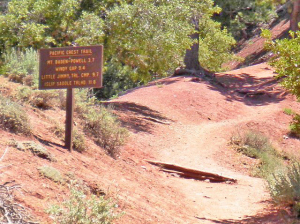Pat Bertram's Blog, page 230
June 27, 2013
How do you give readers the background information they need?
 All my books seem to have a character like Teach, my learned con man from Daughter Am I, who tends to be a lecturer. The hardest part of editing that particular book was to take out everything that wasn’t essential to understanding the story. I worry that Teach’s talk about the history of gold is a bit much, but there is no way to understand why the gold was buried without understanding the history of the era. I did try to space the information to add a bit of suspense at times or to offer a respite from the action at other times.
All my books seem to have a character like Teach, my learned con man from Daughter Am I, who tends to be a lecturer. The hardest part of editing that particular book was to take out everything that wasn’t essential to understanding the story. I worry that Teach’s talk about the history of gold is a bit much, but there is no way to understand why the gold was buried without understanding the history of the era. I did try to space the information to add a bit of suspense at times or to offer a respite from the action at other times.
For Light Bringer, I had to present various conspiracy theories, and instead of having a character like Teach to “teach” the theories, I created a discussion group, each member of which believed a different theory and vociferously defended it while denigrating what the others believed. It was a fun way to present the information without an extended information dump.
Here are some responses from other authors about giving readers the background information they need. The comments are taken from interviews posted at Pat Bertram Introduces . . .
From an interview with Donna Galanti, Author of “A Human Element”
I try to tease them with only a few descriptive details of backstory and setting as I go along. Give them only what they need at the time. Readers want to feel smart. They like to fill in the blanks, as long as there aren’t too many blanks. I try and look at all backstory and gauge if it serves the story. If it doesn’t out it goes. By introducing questions early on with giving just enough information to keep the story going, we involve the reader, take them along for the ride, and…build suspense. Hopefully!
From an interview with Sam Lopez, author of “Dead Sea”
Disputes between characters can provide helpful information but if there is no conflict, then sometimes you just have to spell out what needs saying.
What about you? How do you deal with exposition and give readers the background information they need?
(If you’d like me to interview you, please check out my author questionnaire http://patbertram.wordpress.com/author-questionnaire/ and follow the instruction.)
***
Pat Bertram is the author of the suspense novels Light Bringer, More Deaths Than One, A Spark of Heavenly Fire, and Daughter Am I. Bertram is also the author of Grief: The Great Yearning, “an exquisite book, wrenching to read, and at the same time full of profound truths.” Follow Pat on Google+. Like Pat on Facebook.
Tagged: author interviews, being a writer, editing, essential to the story, exposition, presenting background information


June 26, 2013
We Are All Successful
Someone told me today that my pessimism is keeping me from being a success. Hmm. Not a success? Pessimistic? That’s not how I see myself.
Maybe I do come across as pessimistic, but I am only trying to tell my truth, which is all anyone can do. And admittedly, I am not a success by worldly standards. I haven’t made a lot of money working at a corporate job or playing the stock market. Haven’t made much money at all, if I’m being honest. I have earned no title, won no real awards, never been feted or lionized. No more than a handful of people would show up at my funeral.
Although I would have liked to have sold a huge number of books and have a large enough bank account to indulge myself, for the most part, I’ve never wanted material things. Things weigh me down, make me feel earthbound and claustrophobic. Things demand attention and care, and I’d rather devote my time to nothings. Love, freedom, and truth for example. These aren’t “nothing”, of course, but they are “no thing” — they have no materiality. And in these no things, I am a success.
I loved deeply, and even when that love didn’t bring me fairy-tale happiness, I remained true to my love. Although I was not successful in helping my life mate/soul mate get what he wanted in life, perhaps in the end, I gave him what he needed: someone to be there to witness his life, someone to make sure he was comfortable during his final days, someone to take care of his after death tasks. Maybe he even needed someone to grieve for him, to feel his absence, to acknowledge his importance in the world, and that I gave him. Like me, he wasn’t much of a success in worldly things, but his life had so much weight, when he left the world, my world tilted on its axis.
Freedom is something I have always valued. Freedom, and free time. Freedom from the drudgery of a demanding career so I have time to do the things I want. Freedom from things so I have time for no things. I always had time to indulge my various passions, such as reading. For many years, I read every moment I could, often reading  far into the night, until finally, during the past year, I had a surfeit of reading. Now I am looking for new passions, though I have not yet found any. (Or perhaps it would be more accurate to say they have not yet found me.)
far into the night, until finally, during the past year, I had a surfeit of reading. Now I am looking for new passions, though I have not yet found any. (Or perhaps it would be more accurate to say they have not yet found me.)
I am not yet a success in truth, but then no one is. Truth is something we learn throughout our life, getting deeper and deeper into the truth of truth. I am still on my quest for truth, and someday, maybe, I will know the truth of life, of love, of truth itself.
What someone thinks of me, what of their own values they bestow on me (pessimism seem to be a value judgment more than hard truth), has not mattered in a long time, and that, too, makes me a success.
In many respects, my life has not yet begun. Since the death of my life mate/soul mate, and the concurrent death of our shared existence, I was born into a new life. The whole world is mine to do with as I wish, a blank slate, unwritten with failure, ready for success in whatever shape it comes.
Come to think of it, isn’t success also a value judgment? Not everyone’s dreams come true, not everyone achieves worldly success, but everyone is a success at something, even if it is only managing to get through another day.
***
Pat Bertram is the author of the suspense novels Light Bringer, More Deaths Than One, A Spark of Heavenly Fire, and Daughter Am I. Bertram is also the author of Grief: The Great Yearning, “an exquisite book, wrenching to read, and at the same time full of profound truths.” Follow Pat on Google+. Like Pat on Facebook.
Tagged: Failure, freedom and fee time, pessimism, quest for truth, Success


June 25, 2013
Dreaming Time is Here
After profound grief winds down, there should be a more noble state than the period of disgruntlement and dissatisfaction I am now experiencing. It’s possible this dissatisfaction is a precursor to taking action as some people have suggested, but the truth is, I still have no idea what action to take. I have no real dreams, no list of wants left unfulfilled, no idea of where to go with my life.
To be honest, I can’t go anywhere, not yet. I am still looking after my 96-year-old father, which limits me to some extent, yet at the same time offers me enough freedom to roam the nearby desert, to indulge myself in small ways, to dream.
One benefit of having let myself feel every cyclonic and cyclic aspect of my grief is that I have experienced the worst it can throw at me (at least I presume I have), so I don’t have to keep busy to prevent myself from thinking. I am free to let my mind roam  without fear of where it will take me. Sometimes I think of where I’d like to travel, what I’d like to do, what I’d like to be. Other times, I let the cool desert winds blow all thoughts out of my head and wait to see what flows back to me.
without fear of where it will take me. Sometimes I think of where I’d like to travel, what I’d like to do, what I’d like to be. Other times, I let the cool desert winds blow all thoughts out of my head and wait to see what flows back to me.
Someday I will travel. Someday I will finish my poor work-in-pause. Someday I will set up my barbells. Someday I will . . .
But today, now, I am content to let the thoughts flow, dreaming up possibilities, like a child, with no regard to probability.
I am in no shape to trek the length of the Pacific Crest Trail and yet I can dream and perhaps one day I will hike a small part of it. I don’t have the knees for running anymore, yet I can still dream of the freedom it once gave me. I am basically a hermit, yet I can dream of making friends and charming people wherever I go.
Perhaps fantasizing is a more noble state to follow the waning of profound grief than disgruntlement. Or not. Either way, dreaming time is here.
***
Pat Bertram is the author of the suspense novels Light Bringer, More Deaths Than One, A Spark of Heavenly Fire, and Daughter Am I. Bertram is also the author of Grief: The Great Yearning, “an exquisite book, wrenching to read, and at the same time full of profound truths.” Follow Pat on Google+. Like Pat on Facebook.
Tagged: dissatisfaction, dreaming time, Pacific Crest Trail, what comes after grief


June 24, 2013
A New and Embarrassing Stage of Grief
I’ve gone through so many stages of grief since the death of my life mate/soul mate that I’ve lost track. To be honest, I’m not sure there really are such things as “stages.” There simply seem to be varying states of mind that come around repeatedly in an ever-loosening spiral. Still, “stage” is an understandable term for an incomprehensible process, so I use it to describe each new phase of my grief, such as this latest manifestation.
A couple of things have happened lately to catapult me into a new and embarrassing stage of grief.
The first thing that happened was I finished watching the movies my deceased mate had taped. Viewing the movies was the final task of my Grief Work, and it exacted an emotional toll I hadn’t expected. As I watched each of tapes, I was aware that the last time I saw the movie, he was by my side. I remember the things we said, the looks we gave each other, the connection we felt. These once-loved movies now seem dull and bland as if a vital spark is missing. And it is missing. He is missing. Watching wasn’t hard at the beginning, when I started my self-imposed grief task, but it took more than two years to go through all the tapes, and the sadness built up, sort of like a cinematic water torture.
But that is finished. In the future, whatever feelings the movies instill in me when I watch them won’t be so achingly raw. Time, life, and new experiences will pad the movies, and separate me from him just a bit more. Once that thought of increased separation would have brought me pain, but now I know it’s necessary if I ever hope to live a full life.
The second thing that happened is that I do not have as many mixed feelings about his death as I once did. Many people insist that grief is for us, not for the deceased, but I’ve been greatly troubled by his death — for him. He didn’t seem to have much of a life. He’d been sick for so long and in such pain that he was often housebound and couldn’t do much. He was also relatively  young. Hadn’t reached retirement age. Even worse, too many of his dreams never came true. It seemed to me that he got cheated out of so much, which was hard for me to bear. On the other hand, I was glad his suffering was over. Sometimes I even thought he got the better part of the deal since he didn’t have to hang around as I do to pick up the pieces of a shattered life. But when those pieces are roughly pasted together, I will get a chance to start over, and he won’t. Conflicts such as these complicate grief. But the other day while walking in the desert, I had a revelation — well, two revelations — that helped alleviate these particular conflicts.
young. Hadn’t reached retirement age. Even worse, too many of his dreams never came true. It seemed to me that he got cheated out of so much, which was hard for me to bear. On the other hand, I was glad his suffering was over. Sometimes I even thought he got the better part of the deal since he didn’t have to hang around as I do to pick up the pieces of a shattered life. But when those pieces are roughly pasted together, I will get a chance to start over, and he won’t. Conflicts such as these complicate grief. But the other day while walking in the desert, I had a revelation — well, two revelations — that helped alleviate these particular conflicts.
First, I realized that when I was dead, I’d no longer care that he died before me, so if it is inevitable that someday it won’t matter that he died so soon, perhaps it doesn’t matter as much now. Second, I realized that if somehow we are eternal, existing before this life as well as afterward, then his death and mine would happen simultaneously in a cosmic sense. (If life is eternal, then there is no time, right? It all exists now. And so right now we are both alive/dead, though he is . . . perhaps . . . more dead than I am. Or thinking of it a different way: my potential extra decades of life will happen in an eye blink of eternal time, so from his current point of view, I will follow immediately after him.)
Finishing my final grief task and resolving my mixed feelings has more or less ended my sorrow. (At least for now. Sorrow at the death of the person who connected you to this earth never completely disappears.)
And after the sorrow? Well, this is the part I am embarrassed to admit. I am disgruntled and dissatisfied. It seems as if such profound grief, great yearnings, and impenetrable sadness should dwindle into something more noble than discontent. Besides, disgruntlement should be something I can control, but as with every other stage of grief, it seems to be outside of me. Or inside of me. Either way, it’s not of me. It’s just a stage to pass through on my way to whatever lies on the other side of grief.
***
Pat Bertram is the author of the suspense novels Light Bringer, More Deaths Than One, A Spark of Heavenly Fire, and Daughter Am I. Bertram is also the author of Grief: The Great Yearning, “an exquisite book, wrenching to read, and at the same time full of profound truths.” Follow Pat on Google+. Like Pat on Facebook.
Tagged: conflicts complicate grief, grief task, grief work, mixed feelings about the death of a spouse, stages of grief, what comes after grief


June 23, 2013
Sample Sunday
If you’ve been wanting to check out my books, now is your chance to read the first chapter of each novel online. Who knows, you might get so intrigued you will want to buy one of the book to take with you to the beach this summer or read on an airplane. (Or, for my friends in the southern hemisphere, you might decide one is the perfect companion to read by the fire on a chilly winter’s eve.) I hope you will enjoy sampling a “Pat Bertram” book.
 Bob Stark returns to Denver after 18 years in SE Asia to discover that the mother he buried before he left is dead again. At her new funeral, he sees . . . himself. Is his other self a hoaxer, or is something more sinister going on?
Bob Stark returns to Denver after 18 years in SE Asia to discover that the mother he buried before he left is dead again. At her new funeral, he sees . . . himself. Is his other self a hoaxer, or is something more sinister going on?
Click here to read the first chapter: More Deaths Than One
***
 In quarantined Colorado, where hundreds of thousands of people are dying from an unstoppable, bio-engineered disease, investigative reporter Greg Pullman risks everything to discover the truth: Who unleashed the deadly organism? And why?
In quarantined Colorado, where hundreds of thousands of people are dying from an unstoppable, bio-engineered disease, investigative reporter Greg Pullman risks everything to discover the truth: Who unleashed the deadly organism? And why?
Click here to read the first chapter of: A Spark of Heavenly Fire
***
 When twenty-five-year-old Mary Stuart learns she inherited a farm from her recently murdered grandparents — grandparents her father claimed had died before she was born — she becomes obsessed with finding out who they were and why someone wanted them dead.
When twenty-five-year-old Mary Stuart learns she inherited a farm from her recently murdered grandparents — grandparents her father claimed had died before she was born — she becomes obsessed with finding out who they were and why someone wanted them dead.
Click here to read the first chapter of: Daughter Am I
***
 Thirty-seven years after being abandoned on the doorstep of a remote cabin in Colorado, Becka Johnson returns to try to discover her identity, but she only finds more questions. Who has been looking for her all those years? And why are those same people interested in fellow newcomer Philip Hansen? And what do they have to do with a secret underground laboratory?
Thirty-seven years after being abandoned on the doorstep of a remote cabin in Colorado, Becka Johnson returns to try to discover her identity, but she only finds more questions. Who has been looking for her all those years? And why are those same people interested in fellow newcomer Philip Hansen? And what do they have to do with a secret underground laboratory?
Click here to read the first chapter of: Light Bringer
***
 Pat Bertram is the author of Light Bringer, More Deaths Than One, A Spark of Heavenly Fire, and Daughter Am I.All Bertram’s books are available both in print and in ebook format. You can get them online at Second Wind Publishing, Amazon, B&N and Smashwords. At Smashwords, the books are available in all ebook formats including palm reading devices, and you can download the first 20-30% free!
Pat Bertram is the author of Light Bringer, More Deaths Than One, A Spark of Heavenly Fire, and Daughter Am I.All Bertram’s books are available both in print and in ebook format. You can get them online at Second Wind Publishing, Amazon, B&N and Smashwords. At Smashwords, the books are available in all ebook formats including palm reading devices, and you can download the first 20-30% free!
Tagged: A Spark of Heavenly Fire, Daughter Am I, first chapters, Light Bringer, More Deaths Than One, Pat Bertram


June 22, 2013
Serial Killers and Sociopaths
Despite fads and new genres, serial killers endure as a favorite villain for writers and readers alike, though I lost my taste for such books years ago. For one thing, too many writers use killing as a cheap way of escalating tension, with each murder upping the ante. For another thing, too many writers perpetuate the serial killer myth of the white, middle-class, intelligent, charming male about thirty-five years old.
Dr. Katherine Ramsland, a forensic psychologist, debunks this stereotype in a guest post she did for this blog: Serial Killers and the Writers Who Love Them: Facts about Popular Myths. As Ramsland points out, “Serial killers are not all alike. They’re not all male. Some have been as young as eight or older than fifty. They’re not all driven by sexual compulsion. They’re not all intelligent, nor even clever – often, they’re just lucky. They’re not all charming. A single killer may choose different weapons or methods of operation, although they will tend to stay with whatever works best. Even with rituals, the basis of a ‘signature,’ they often experiment and change things. They might be profit-driven, in search of thrill or self-gratification, or compelled by some other deep-seated desire, fear or need. Occasionally, serial murder is about revenge or it’s inspired by a delusion. In most cases, the killer does not wish to be stopped or caught. Yet a few do intentionally undermine themselves or stop of their own accord. Some rare killers have even professed remorse or killed themselves.”
Far more fascinating to me are the sociopaths who don’t kill. Some psychologists estimate that there are thirty thousand  psychopaths who are not serial killers for every one who is. (Some professionals use “sociopath” and “psychopath” interchangably as I am doing and some argue there is a difference, but oddly, no one seems to agree on what those differences are.)
psychopaths who are not serial killers for every one who is. (Some professionals use “sociopath” and “psychopath” interchangably as I am doing and some argue there is a difference, but oddly, no one seems to agree on what those differences are.)
So who are these non-killing psychopaths? Your neighbor, perhaps, or your mother-in-law. Probably many politicians and scientists. Possibly even you.
(In A Spark of Heavenly Fire, Peter Jensen says: “I have a theory, entirely unproven, that a lot of psychopaths gravitate to the sciences, biology especially, where they can hide behind that famed scientific detachment. They can also torture animals in the name of science, and no one calls them insane.”)
Even if you don’t write crime fiction, familiarity with the sociopathic personality can help you create dynamic characters and even interesting dialogue. For example, sociopaths frequently use contradictory and illogical statements such as “I never touched her, and anyway, she wanted it.”
A sociopath has difficulty connecting to others, though people often like them. They can be charming, glib, witty, and use captivating body language. (Sounds like a politician, doesn’t it?) Because of their impulsiveness, need for excitement, no need to conform to societal standards, poor behavior controls, and lack of responsibility, they can be fun companions, but because they lack empathy, conscience, and remorse, they can never truly connect with anyone.
One characteristic that keeps a sociopath from being a good fiction hero is that in fiction heroes need to change during the course of the novel, and sociopaths have solid personalities that are extremely resistant to outside influences. But, being the manipulative creatures that they are, they can make us believe they have changed.
In a relationship, such manipulation might be intolerable, but in fiction, it makes for a interesting character, even if the character isn’t a killer.
***
Pat Bertram is the author of the suspense novels Light Bringer, More Deaths Than One, A Spark of Heavenly Fire, and Daughter Am I. Bertram is also the author of Grief: The Great Yearning, “an exquisite book, wrenching to read, and at the same time full of profound truths.” Follow Pat on Google+. Like Pat on Facebook.
Tagged: Dr. Katherine Ramsland, popular myths about serial killers, psychopath, serial killer, serial killer profile, sociopath


June 21, 2013
Is Our Grief Necessary to the Dead?
I talked to my deceased life mate/soul mate while I was out walking in the desert this morning. I apologized for keeping him tied to me with my grief, told him I hadn’t meant to shed so many tears for him or grieve for so long, and explained that much of my grief came from somewhere so deep inside that I had no conscious control over it.
I told him I was doing okay, so perhaps I wouldn’t be bothering him as much, and I wished him well.
I continued wandering, wondering about the incomprehensibleness of grief, and the thought came to me that perhaps such profound grief is a beacon, as necessary to the dead as it is to the living.
During the last weeks of my mate’s death, he was often agitated and confused due to both the cancer in his brain and the morphine he needed to control his pain. Once he woke screaming. I went to calm him, but he was frantic. He couldn’t remember  who he was. “Do you remember me?” I asked. He studied my face, nodded his head, and immediately started to calm down. A few minutes later, he’d recovered enough to remember who he was.
who he was. “Do you remember me?” I asked. He studied my face, nodded his head, and immediately started to calm down. A few minutes later, he’d recovered enough to remember who he was.
What if after he died, he felt as horribly and as bewilderingly amputated as I did? What if his new world felt as alien as mine did? What if my grief, so incredibly powerful, served as a beacon the same way my presence did that night? What if my grief showed him where I was and gave him something familiar to focus on until he could get his bearings?
We are indoctrinated by religion and by stories of near death experience into believing that death is an immediate rebirth into the light, but no one knows the truth of it. (Many people who have near death experiences do not see the light, but see darkness. Some people whose heart stops have no experiences. The truth is, the brain releases powerful psychedelic chemicals during trauma that can induce such mystical experiences. Many people who took LSD or DMT and had good trips returned to themselves believing they had died and experienced God and the after life. But although many people think they know the truth of it, no one on this side of death can know for sure.)
Someone who died abruptly might not know what happened. Someone who died slowly but in confusion and disorientation might not know what happened. This sort of thing isn’t unheard of; it occurs here on Earth. A person who is given sight after being blind since birth often cannot immediately see except a fuzzy light. The brain needs to be trained so that it knows what it is seeing. Perhaps the newly dead also need to be trained to see through their new eyes. And if so, the grief of a loved one could provide a beacon until they get their bearings.
The desert is known for inducing mysticism in people who wander those empty spaces, so there could be some truth to this. On the other hand, it was very hot, and I might have had sunstroke. Either way, the idea of grief being a beacon is an interesting concept, one that will stew in my brain pan for a while.
***
Pat Bertram is the author of the suspense novels Light Bringer, More Deaths Than One, A Spark of Heavenly Fire, and Daughter Am I. Bertram is also the author of Grief: The Great Yearning, “an exquisite book, wrenching to read, and at the same time full of profound truths.” Follow Pat on Google+. Like Pat on Facebook.
Tagged: death as amputation, death as rebirth, do the dead feel grief, grief as a beacon, what happens when we are dead


June 20, 2013
Searching for Faults
When I unexpectedly and quite surprisingly found myself a few miles from the San Andreas Fault, I was at first appalled and then fascinated. Such a mythical place! Who hasn’t heard the warnings of “the big one” and the quite erroneous assertion that when it hits, Arizona will become beachfront property?
I have plenty of faults of my own, so I don’t need to go searching for personal faults, but I did go in search of the myth. As I mentioned yesterday, there is no giant crack in the earth, and in many places there is no indication at all of the fault line. Erosion, bulldozers, plows, and buildings have all helped to eradicate any “line.”
Still, there are signs. This “lake” (more of a pond, really) is actually a fault sag, a place where the land sank as a result of earth movement along the fault. Water is collected in the lake from rain, snow melt, and underground springs.
Somewhere down in these narrow gorges is the fault line. Supposedly it is visible as it dips south and west, though I couldn’t see whatever it was I was supposed to see.
I could see better indication of the fault line here, because it is marked by the red sedimentary rock. The gray schist is the local rock, but fault action shifted the red rocks to their present location.
This search was an incredible journey, and as you can see, a beautiful one. Wouldn’t it be wonderful if all our personal faults were as hard to find as this geographical fault and as colorful and dramatic when we did catch a glimpse of them?
***
Pat Bertram is the author of the suspense novels Light Bringer, More Deaths Than One, A Spark of Heavenly Fire, and Daughter Am I. Bertram is also the author of Grief: The Great Yearning, “an exquisite book, wrenching to read, and at the same time full of profound truths.” Follow Pat on Google+. Like Pat on Facebook.
Tagged: fault sag, red sedimentary rock, San Andreas Fault, searching for the San Andreas Fault, the big one


June 19, 2013
Today I Will Be . . . At Fault
Or maybe I’ll be fautless. It all depends on how the day goes.
I’m smiling as I write this, hoping you find my pun as groaningly amusing as I do. The truth is, a couple of friends and I are going on a trip to look for the San Andreas Fault. It’s not as simple a matter as it might seem. Apparently, there is no giant crack in the earth. According to the San Andreas Fault website (yep, the SAF as it is so affectionately called, has its own website): ”The SAF has not had a major ground-rupturing earthquake since 1906. Virtually all traces of the ‘giant cr ack in the ground’ that so many people image the SAF to be have been erased. Erosion fills and covers the fault, plows and bulldozers reshape the surface, roads and neighborhoods are built on the fault. The actual surface trace of the fault is subtle. What one has to look for are the land forms that the plate motion has created.”
ack in the ground’ that so many people image the SAF to be have been erased. Erosion fills and covers the fault, plows and bulldozers reshape the surface, roads and neighborhoods are built on the fault. The actual surface trace of the fault is subtle. What one has to look for are the land forms that the plate motion has created.”
Really? Neighborhoods are built on the fault? I suppose it makes sense — that would have been the last bit of available land in many places, and probably relatively cheap, such as all the trailer parks that were build on flood plains and in tornado alleys.
Even though a “big one” is expected sometime this century, you don’t have to worry about my being swallowed up by an earthquake. According to a publication called Putting Down Roots in Earthquake Country, “A popular literary device is a fault that opens during an earthquake to swallow up an annoying character. But unfortunately for principled writers, gaping faults exist only in novels. The ground moves across a fault during an earthquake, not away from it. If the fault could open, there would be no friction. Without friction, there would be no earthquake.”
So, not only will I not fall in, I can’t use that idea for a story, which I’d actually thought of doing. Still, if I disappear, you will no where to find me. Hmmm. “No where” instead of “know where?” I thought it apropros, so I left in the typo. I hope it’s not a portent for the day.
***
Pat Bertram is the author of the suspense novels Light Bringer, More Deaths Than One, A Spark of Heavenly Fire, and Daughter Am I. Bertram is also the author of Grief: The Great Yearning, “an exquisite book, wrenching to read, and at the same time full of profound truths.” Follow Pat on Google+. Like Pat on Facebook.
Tagged: at fault, earthquakes, fault lines, literary device, San Andreas Fault, the big one


June 18, 2013
The Loosening Spiral of Grief
Yesterday I wrote about The Unchanging Face of Grief, and how a journal entry I wrote exactly three years ago mirrored what I was feeling — Just drifting. Marking time. Hoping . . .
But the truth is, there is a vast difference between yesterday’s feelings and those of three years ago. Three years ago, when I wrote that entry, I had accomplished most of what I needed to do immediately after the death of my life mate/soul mate. I had him cremated as he wished, opened a new checking account, disposed of most of his effects and a lot of “our” things that weren’t  worth storing, got myself to my father’s house to look after him since he could no longer live alone. There was nothing I needed to do, that day three years ago, and the great pain of grief provided insulation from the normal irritations and aggravations of life, offering me the illusion of freedom. I just drifted in a fog of pain, spending hours in the desert, thinking not much of anything. Just wandering. Marking time. Hoping my life was actually going somewhere and wouldn’t always feel so stagnant.
worth storing, got myself to my father’s house to look after him since he could no longer live alone. There was nothing I needed to do, that day three years ago, and the great pain of grief provided insulation from the normal irritations and aggravations of life, offering me the illusion of freedom. I just drifted in a fog of pain, spending hours in the desert, thinking not much of anything. Just wandering. Marking time. Hoping my life was actually going somewhere and wouldn’t always feel so stagnant.
People often talk about the “stages” of grief, as if grief were a staircase you ascend, step by agonizing step, until you climb out of the pit, but grief is more like a spiral that slowly unrolls, returning you over and over to the same places, each time with a bit less pain and emotion. At the beginning, these changes from vast pain to numbness, from despair to hope, from determination to helplessness come so quickly, it’s as if you’re inside a slinky that some over-active child keeps tossing around. You don’t even have time to acknowledge one state of mind before you’re in a different state.
My spiral of grief is still unrolling, but now, after more than three years, the changes come slowly and have little power. And the upsurges of angst are over quickly. But this feeling of waiting, of stagnation, seems to be ever present.
I don’t seem to be going anywhere with my life. I remember at the beginning, I was anxious to be done with my grief so I could embrace my new life with arms outstretched. I expected wonderful things to happen, and why shouldn’t they? Doesn’t it make sense that great happiness should come to balance out such great pain? But here I am, long past the worst of my pain, and I still seem to be running in place.
Admittedly, I am stuck in place geographically, unable to make plans except for a few days in advance since my father’s health takes precedence, but my life has more often been a life of the mind instead of action, and that mental life seems stuck too. Even worse, the waning pain of grief no longer protects me from the aggravations of life. (And right now there seem to be more aggravations than normal.)
I have had a couple of revelations out walking in the desert though, so perhaps I am not stagnating as much as I think I am. A few days ago, I was talking to my deceased mate, complaining about all the aggravations I have to deal with, and telling him that when I was free to live my own life, I still wouldn’t be free since I have other commitments to consider. A few minutes after I shut up and the walking lulled my mind, the thought entered my head, “Don’t consider other people. Do what you want.”
(I’m pretending this thought came from him in response to my complaints, but more probably it came from my subconscious.) Doing what I want is easy. Figuring out what I want is hard, but maybe someday it will come to me as I wander.
Another revelation, that I’m not sure I understand, is that life is a tool that we write with, much as we write with a pen. I’m still thinking about that one.
Despite the feelings of going nowhere, I am still trying to keep open to “somewhere.” Still trying to embrace life. Still trying . . .
***
Pat Bertram is the author of the suspense novels Light Bringer, More Deaths Than One, A Spark of Heavenly Fire, and Daughter Am I. Bertram is also the author of Grief: The Great Yearning, “an exquisite book, wrenching to read, and at the same time full of profound truths.” Follow Pat on Google+. Like Pat on Facebook.
Tagged: grief and feelings of waiting, grief and loneliness, grief and marking time, grief at three years, grief journal, spiral of grief, stages of grief








